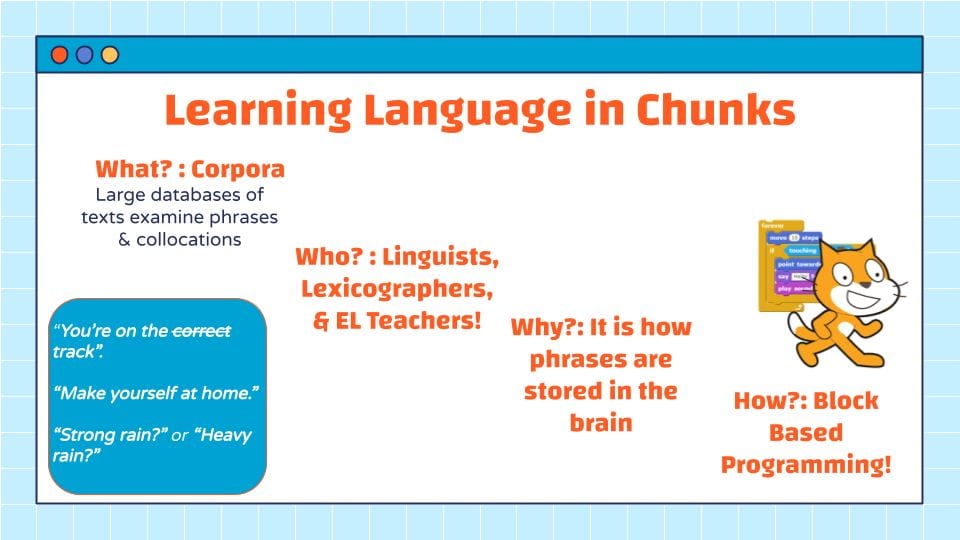Move.
Move forward.
Often when we think of a world language lesson, we remember vocabulary lists and grammar rules. Language is also stored in the brain in chunks and semantic groupings.
Word up!
What are chunks? Ben Zimmerman describes it as “meaningful strings of language that are committed to memory. Chunks may consist of fixed idioms or conventional speech routines, but they can also simply be combinations of words that appear together frequently, in patterns that are known as ‘collocations.’ (Nytimes, 2010). The WIDA standards, the K-12 language standards adopted by 42 of 50 states, note increasing competence in expressions and phrases as a mark of growing fluency in its vocabulary/phrases usage column of its interpretive rubrics.
Linguists utilize corpora to analyze large data sets to identify these collocations and patterns of words for research. (Sound familiar, computer scientists?) For EL teachers, the implications are that we should leverage this science how the brain stores language in phrases and explicitly teach language phrases, chunks, and idioms. It’s a well established approach in second language acquisition, “The Lexical Approach,” first introduced by Michael Lewis in the 90s. He calls for traditional language teachers to reject the traditional vocabulary/ grammar dichotomy and reimagine the language classroom (T-ESJ, 1997).

So let’s re-image the language classroom and take it a step further with computer science integration. Here’s where block programming comes in. Lines of code, that is, meaningful strings of language, are chunked in blocks. Students participate in reading and acquire language in chunks as they manipulate the blocks. Beginning programmers can easily code by dragging and dropping these blocks in an algorithm, which fit together like a puzzle. They test their code and receive instant feedback how they use the blocks of code phrases/ chunks of language as they test the code. And repeat. As sung by House of Pain, “Word to your moms, I came to drop bombs”–
–No longer do we teach and learn from just word lists.
Visual programming languages, like Scratch, go even further. They add another visual element by color coding the blocks according to their functions. Color further embeds the language in the brain. When learning language, we know that phrases related to visual experiences are stored together. Computer scientists will describe a benefit of visual programming is for ease of use. Psycholinguists would describe how the brain works this way too—we chunk language for ease of use. Linguist Schmitt in his 2000 article in ELT teaching, describes this: “There is less demand on cognitive capacity, because the lexical chunks are ‘ready to go’, and require little or no additional processing.” And, color coded chunks, works with the brain for learning language.
There’s a lot more to be said for this connection between chunking and the benefits of exploring and creating with visual programming blocks for English learners. It is my firmly held belief that integrating visual programming projects to teach language could be transformational to the language teaching community. With a teacher as learner mindset, our classrooms can be labs for innovative language teaching and learning. As for me, this connection is a huge motivator to continue to integrate CS in English language development instruction!